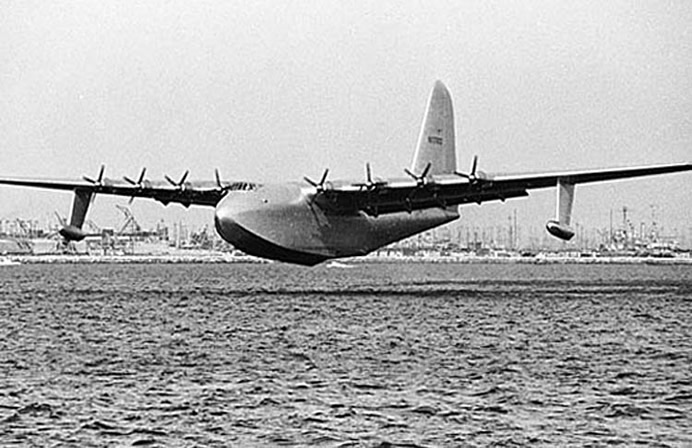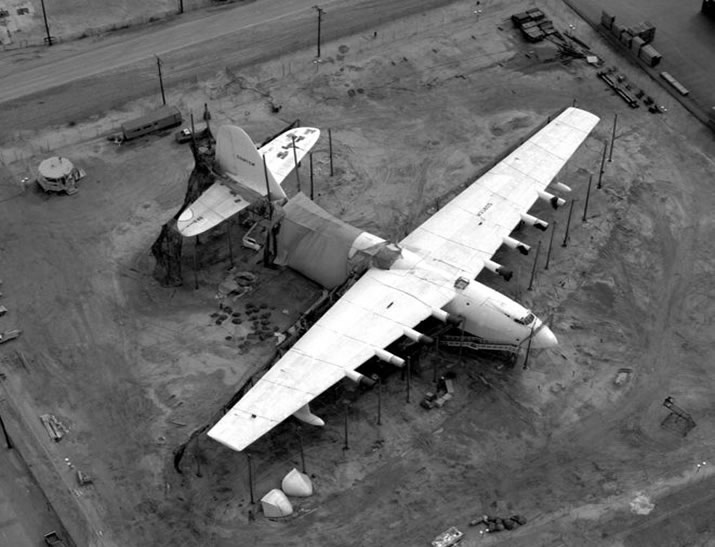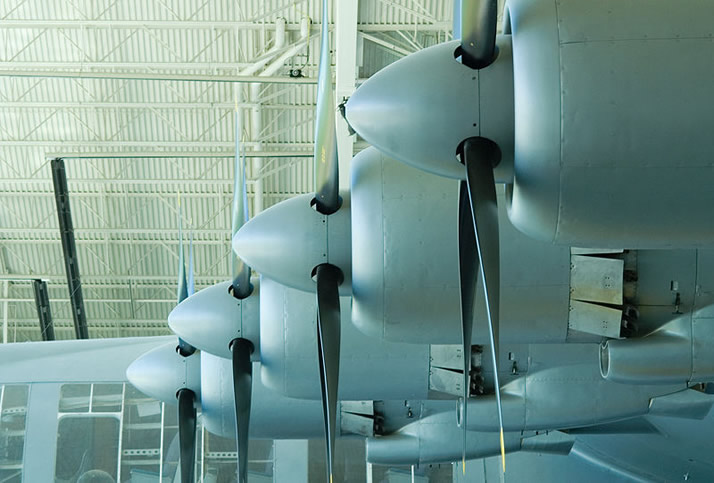SPRUCE GOOSE H-4 HERCULES
AIRCRAFT HISTORY, FACTS AND PICTURES
 |
The Hughes H-4 Hercules (registration NX37602) was a prototype heavy transport aircraft designed and built by the Hughes Aircraft company.The aircraft made its first and only flight on 2 November 1947. Built from wood due to wartime raw material restrictions on the use of aluminum, it was nicknamed the "Spruce Goose" by its critics. The Hercules is the largest flying boat ever built, and has the largest wingspan and height of any aircraft in history. It survives in good condition at the Evergreen Aviation Museum in McMinnville, Oregon. Read about the man behind the Spruce Goose - Howard Hughes Due to wartime restrictions on the availability of metals, the H-4 was built almost entirely of laminated birch, not spruce as its nickname suggests. The Duramold process, a form of composite technology, was used in the laminated wood construction. The aircraft was considered a technological tour de force. It married flying boats to a massive wooden airframe that required some ingenious engineering innovations to function.
Ultimately, the plane was not finished in time for use in the war and never advanced beyond the single prototype produced. In 1942, the U.S. Department of War was faced with the need to transport war materiel and personnel to Britain. Allied shipping in the Atlantic Ocean was suffering heavy losses to German U-boats, so a requirement was issued for an aircraft that could cross the Atlantic with a large payload. For various reasons with regard to wartime priorities, the design was further constrained in that the aircraft could not be made of metal. The aircraft was the brainchild of Henry J. Kaiser, who directed the Liberty ships program. He teamed with aircraft designer Howard Hughes to create what would become the largest aircraft built or even seriously contemplated at that time. When completed, it was capable of carrying 750 fully-equipped troops or one M4 Sherman tank. The original designation "HK-1" reflected the Hughes and Kaiser collaboration.
The HK-1 contract in 1942, issued as a development contract, initially called for three aircraft to be constructed under a two-year deadline in order to be available for the war effort. Seven different configurations were considered including twin-hulled and single-hulled designs with combinations of four, six and eight, wing-mounted engines. The final design chosen was a behemoth, eclipsing any large transport yet built or even envisioned. To conserve metal, it would be built mostly of wood (elevators and rudder were fabric covered); hence, the "Spruce Goose" moniker tagged on the aircraft by the media. It was also referred to as the Flying Lumberyard by critics who believed an aircraft of its size physically could not fly. Hughes himself detested the nickname "Spruce Goose".
While Kaiser had originated the "flying cargo ship" concept, he did not have an aeronautical background and deferred to Hughes and his designer, Glenn E. Odekirk. Development dragged on which frustrated Kaiser who blamed delays partly on restrictions placed for the acquisition of strategic materials such as aluminum but also placed part of the blame on Hughes' insistence on "perfection." Although construction of the first HK-1 had taken place 16 months after the receipt of the development contract, Kaiser withdrew from the project. The Hercules was a monumental undertaking. It is the largest aircraft ever built. It is over five stories tall with a wingspan longer than a football field. That's more than a city block. Now, I put the sweat of my life into this thing. I have my reputation all rolled up in it and I have stated several times that if it's a failure I'll probably leave this country and never come back. And I mean it.
During a break in the Senate hearings, Hughes returned to California to run taxi tests on the H-4. On 2 November 1947, a series of taxi tests was begun with Hughes at the controls. His crew included Dave Grant as co-pilot, and a crew of two flight engineers, 16 mechanics and two other flight crew. In addition, the H-4 carried seven invited guests from the press corps plus an additional seven industry representatives, for a total of 32 on board. After the first two uneventful taxi runs, four reporters left to file stories but the remaining press stayed for the final test run of the day. After picking up speed on the channel facing Cabrillo Beach near Long Beach, the Hercules lifted off, remaining airborne 70 feet (21 m) off the water at a speed of 135 mph (217 km/h or 117 knots) for around a mile (1.6 km). At this altitude, the aircraft was still experiencing ground effect. Hughes had answered his critics and the hearings ended. The aircraft never flew again. It was carefully maintained in flying condition until Hughes' death in 1976. After years of storage, in 1980, the Hercules was acquired by the California Aero Club, who successfully put the aircraft on display in a large dome adjacent to the Queen Mary exhibit in Long Beach, California. In 1988, The Walt Disney Company acquired both attractions and the associated real estate. Disney informed the California Aero club that they no longer wished to display the Hercules. After a long search for a suitable host, the California Aero Club awarded custody of the Hughes Flying Boat to Evergreen Aviation Museum. On 9 July 1990, under the direction of museum staff, the aircraft was disassembled and moved by barge to its current home in McMinnville, Oregon (about an hour southwest of Portland) where it has been on display since. By the mid-1990s, the former Hughes Aircraft hangars including the one that held the Hercules were converted into sound stages. Scenes from movies such as Titanic, What Women Want, and End of Days have been filmed in the 315,000 square foot (29,000 m²) aircraft hangar where Howard Hughes created the flying boat. The hangar will be preserved as a structure eligible for listing in the National Register of Historic Buildings in what is today the housing development Playa Vista, Los Angeles, California.
Although the project did not move beyond the initial prototype, the H-4 Hercules, in some senses, presaged the massive transport aircraft of the late 20th century, such as the Lockheed C-5 Galaxy, the Antonov An-124 and the An-225. The Hercules demonstrated that the physical and aerodynamic principles which make flight possible are not limited by the size of the aircraft. In the film The Rocketeer (1991), hero Cliff Secord uses a large-scale model of the Hercules to escape some eager federal agents and Howard Hughes himself. After Secord glides the model to safety, Hughes expresses astonishment that the craft might actually fly. The construction and flight of the Hercules was featured in the 2004 Hughes biopic The Aviator. Motion control and remote control models, as well as partial interiors and exteriors, of the aircraft were reproduced for this scene. The motion-control Hercules is on display at the Evergreen Aviation Museum, next to the real Hercules. The aircraft's hold on popular imagination is demonstrated by the 1987 Hanna-Barbera animated film Yogi Bear and the Magical Flight of the Spruce Goose. |
© AviationExplorer.com - The Website For Aviation Enthusiasts |










.jpg)